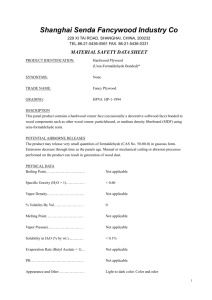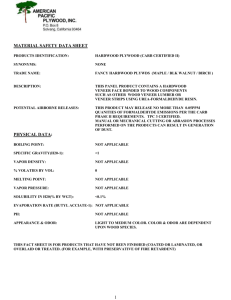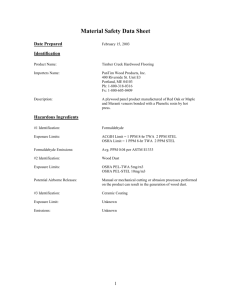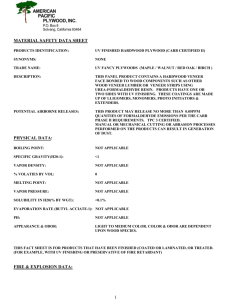MATERIAL SAFETY DATA SHEET PART I: PRODUCT IDENTIFICATION
advertisement
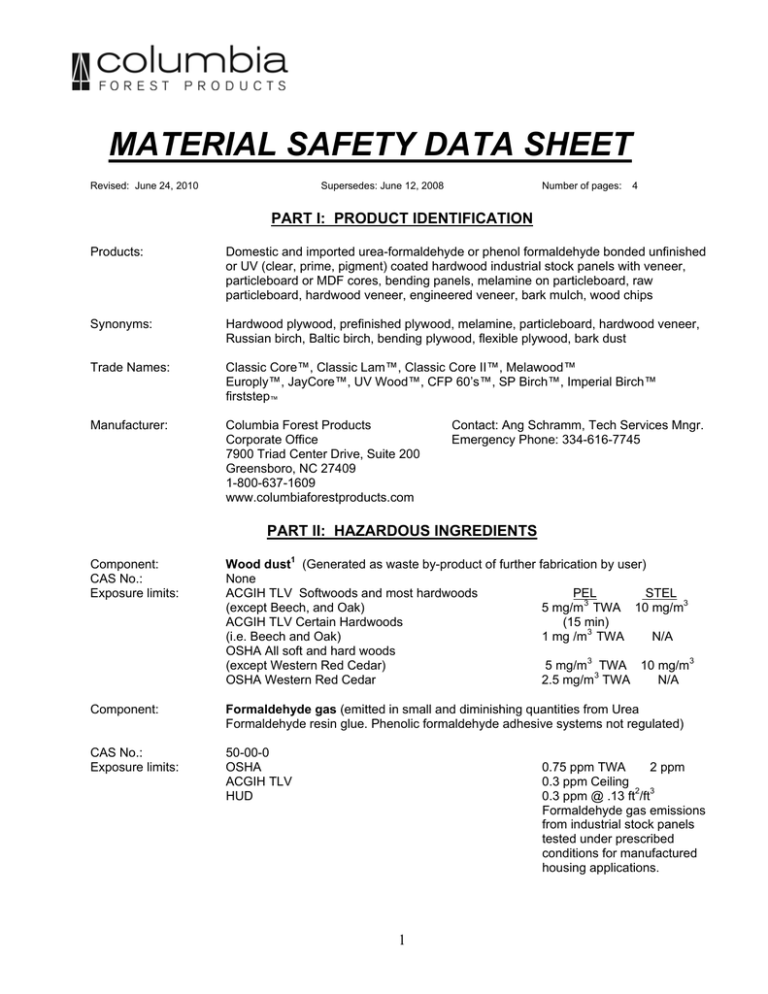
MATERIAL SAFETY DATA SHEET Revised: June 24, 2010 Supersedes: June 12, 2008 Number of pages: 4 PART I: PRODUCT IDENTIFICATION Products: Domestic and imported urea-formaldehyde or phenol formaldehyde bonded unfinished or UV (clear, prime, pigment) coated hardwood industrial stock panels with veneer, particleboard or MDF cores, bending panels, melamine on particleboard, raw particleboard, hardwood veneer, engineered veneer, bark mulch, wood chips Synonyms: Hardwood plywood, prefinished plywood, melamine, particleboard, hardwood veneer, Russian birch, Baltic birch, bending plywood, flexible plywood, bark dust Trade Names: Classic Core™, Classic Lam™, Classic Core II™, Melawood™ Europly™, JayCore™, UV Wood™, CFP 60’s™, SP Birch™, Imperial Birch™ firststep™ Manufacturer: Columbia Forest Products Corporate Office 7900 Triad Center Drive, Suite 200 Greensboro, NC 27409 1-800-637-1609 www.columbiaforestproducts.com Contact: Ang Schramm, Tech Services Mngr. Emergency Phone: 334-616-7745 PART II: HAZARDOUS INGREDIENTS Component: CAS No.: Exposure limits: Wood dust1 (Generated as waste by-product of further fabrication by user) None ACGIH TLV Softwoods and most hardwoods PEL STEL (except Beech, and Oak) 5 mg/m 3 TWA 10 mg/m3 ACGIH TLV Certain Hardwoods (15 min) (i.e. Beech and Oak) 1 mg /m3 TWA N/A OSHA All soft and hard woods (except Western Red Cedar) 5 mg/m3 TWA 10 mg/m3 OSHA Western Red Cedar 2.5 mg/m 3 TWA N/A Component: Formaldehyde gas (emitted in small and diminishing quantities from Urea Formaldehyde resin glue. Phenolic formaldehyde adhesive systems not regulated) CAS No.: Exposure limits: 50-00-0 OSHA ACGIH TLV HUD 0.75 ppm TWA 2 ppm 0.3 ppm Ceiling 0.3 ppm @ .13 ft2/ft3 Formaldehyde gas emissions from industrial stock panels tested under prescribed conditions for manufactured housing applications. 1 PART III: PHYSICAL PROPERTIES Description: Unfinished and UV Finished multi-ply composite wood panels consisting of various combinations of hardwood or decorative veneer faces, bonded to other wood veneers, particleboard, medium density fiberboard, lumber, or hardboard. Generally used in cabinets, furnishings, laminated block flooring, and in other non-structural applications. Typically provided as 4’ X 8’ panels, but available in other sizes. Thicknesses range from under 1/8” to over 1”. Specific gravity: Boiling point: Solubility in water: Appearance/Odor: Usually less than 1, but varies depending on wood species and moisture content. Not applicable. Insoluble. Normal for natural wood. Light to dark in color. Color and odor vary by species and expired time since processing. PART IV: FIRE AND EXPLOSION DATA Flash point: Autoignition temp.: Explosive limits in air: Extinguishing media: Special fire fighting procedures: Unusual fire and explosion hazard: 600o F for wood. Varies (typically 400o F to 500o F) N/A for hardwood plywood. 40 g/m3 (LEL) for wood dust. Water, carbon dioxide, sand Follow established procedures for extinguishing wood source fire. Hardwood plywood does not present an explosion hazard. Sawing, sanding, or machining of hardwood plywood can produce wood dust as a by-product which may present an explosion hazard if a dust cloud contacts an ignition source. An airborne concentration of 40 grams of wood dust per cubic meter of air is often used as the LEL for wood dust. PART V: REACTIVITY DATA Stability: Incompatibility: Hazardous decomposition products: Conditions to avoid: Storage: Hazardous polymerization: Stable under normal conditions. Avoid contact with strong oxidizing agents and drying oils. Avoid open flame. Product may ignite at temperatures in excess of 400o F, depending on length of time of exposure. Thermal and/or thermal oxidative decomposition of wood can produce irritating and toxic fumes and gases, including carbon monoxide, hydrogen cyanide, aldehydes, organic acids, and polynuclear aromatic compounds. High temperatures and high relative humidity increase the rate of formaldehyde emissions. Avoid open flames or other ignition source. In a cool, dry place, away from ignition sources. Provide adequate ventilation. Not applicable. PART VI: HEALTH AND HAZARD DATA: Eye contact: Skin contact: Ingestion: Inhalation: Gaseous formaldehyde may cause temporary irritation or a burning sensation. Wood dust can cause mechanical irritation. Both formaldehyde and wood dust from various species of wood may evoke allergic contact dermatitis in sensitized individuals. Not likely to occur. Wood dust and/or formaldehyde may cause nasal dryness and/or irritation. Coughing, sneezing, wheezing, sinusitis, prolonged colds, and headaches have 2 Chronic effects: also been reported. Both may aggravate preexisting respiratory conditions or allergies. Wood dust may also cause nasal obstruction. Depending on species, wood dust may cause dermatitis on prolonged, repetitive contact. Formaldehyde and/or wood dust may cause respiratory sensitization and/or irritation. Pre-existing respiratory disorders may be aggravated by exposure. Prolonged exposure to wood dust has been reported by some observers of European furniture workers to be associated with nasal cancer. IARC classifies wood dust as a carcinogen to humans (Group 1). This classification is based primarily on IARC’s evaluation of increased risk in the occurrence of adenocarcinomas of the nasal cavities and paranasal sinuses associated with exposure to wood dust. IARC did not find sufficient evidence to associate cancers of the oropharynx, lung, lymphatic, and hematopietic systems, stomach, colon, or rectum with exposure to wood dust. The National Toxicology Program (NTP) has also listed wood dust as a known human carcinogen. Wood dust is not listed as a carcinogen by ACGIH or OSHA. A large case control nasal cancer mortality study in North Carolina, Mississippi, Washington and Oregon (1962-1977) did not demonstrate an association between nasal cancer and occupations normally associated with wood dust. Formaldehyde is listed by IARC as a human carcinogen. NTP includes formaldehyde in the Annual Report on Carcinogens. Formaldehyde is regulated by OSHA as a potential cancer agent. Some rats exposed under laboratory conditions to 14 ppm formaldehyde (a level far exceeding human tolerance limits, and far exceeding that normally found in the workplace) for two years developed a nasal cancer. The Universities Associated for Research and Education in Pathology (UAREP) has stated in a report, Epidemiology of a Chronic Occupational Exposure to Formaldehyde, (December, 1987,) that: “1: For no malignancy in man is there convincing evidence of a relationship with formaldehyde exposure; and 2: Furthermore, that if a relationship does exist, the excess risk, in absolute terms, must be small.” PART VII: PRECAUTIONS AND SAFE HANDLING Ventilation: Personal protective equipment: Fire prevention: Provide adequate ventilation and exhaust to keep airborne contaminant concentration levels below the OSHA PELs, and to reduce the possible buildup of formaldehyde gas, particularly when high temperatures and relative humidity occur. Avoid dusty conditions, and observe same ventilation for wood dust as indicated for formaldehyde. Wear goggles or safety glasses when manufacturing or machining any wood product. Wear NIOSH/MSHA approved respirator when the allowable limits may be exceeded. Other protective equipment, such as gloves and outer garments may be needed, depending on dust conditions. Avoid open flames or other ignition sources. Keep fire extinguisher readily available. PART VIII: EMERGENCY AND FIRST AID PROCEDURES Eyes: Skin: Inhalation: Ingestion: Flush with large amounts of water. Remove to fresh air. If irritation persists, seek medical attention. Wash affected area with soap and water. If rash, persistent irritation, or dermatitis occurs, seek medical attention. Remove to fresh air. Get medical advice if persistent irritation, severe coughing, or breathing difficulty occurs. Not applicable. 3 PART IX: SPILL, LEAK, STORAGE, AND DISPOSAL Pick up, vacuum, or sweep spills for recovery and/or disposal. Avoid creating dusty conditions. Provide good ventilation where dust conditions cannot be avoided during cleanup. Place recovered wood dust in a container for proper disposal. Store in well ventilated area as product will emit small amounts of formaldehyde. Dispose in accordance with Federal, State, and Local regulations. Disposal is the responsibility of the generator. PART X: KEY TO COMMONLY USED ACRONYMS ACGIH: EPA: HUD: IARC: LEL: Mg/m3: MSDS: NTP: OSHA: PEL: PPM: STEL: TLV: TWA: American Conference of Government and Industrial Hygienists Environmental Protection Agency US Department of Housing and Urban Development International Agency for Research on Cancer Lowest explosion limit Milligrams per cubic meter Material Safety Data Sheet National Toxicology Program Occupational Safety and Health Administration Permissible exposure limit Parts per million Short term exposure limit Threshold limit value Time weighted average PART XI: USER RESPONSIBILITY Important: This information is offered in good faith. It is believed to be accurate and has been compiled from sources believed to be reliable. It is offered for your consideration, investigation, and verification. Columbia Forest Products makes no warranty of any kind, expressed or implied, concerning the accuracy or completeness of the information and data herein. Furthermore, Columbia Forest Products will not be liable for claims relating to any party’s use of, or reliance on information and data contained herein, regardless of whether it is claimed that the information and data are inaccurate, incomplete, or otherwise misleading. It is the responsibility of the user to comply with local, state, and/or federal regulations concerning the storage, use, processing, and disposal of the product or subsequently generated waste. It is the responsibility of the user to ensure that this MSDS is the most current version. IMPORTANT FOOTNOTE1 CONCERNING OSHA PELS FOR WOOD DUST In AFL-CIO v. OSHA 965 F. 2d 962 (11th Cir. 1992), the court overturned OSHA’s 1989 Air Contaminants Rule, including the specific PELs for wood dust that OSHA had established at that time. The 1989 PELs were: TWA - 5 mg/m3; STEL (15 min.) - 10.0 mg/m3 (all soft and hard woods except Western red cedar); Western red cedar TWA-2.5 mg/m3. Wood dust is now officially regulated as an organic dust under the Particulates Not Otherwise Regulated (PNOR) or Inert or Nuisance Dust categories at PELs noted under PART II of this MSDS. However, a number of states have incorporated provisions of the 1989 standard in their state plans. Additionally, OSHA has announced that it may cite companies under the OSH Act General Duty Clause under appropriate circumstances for non-compliance with the 1989 PELs. 4

